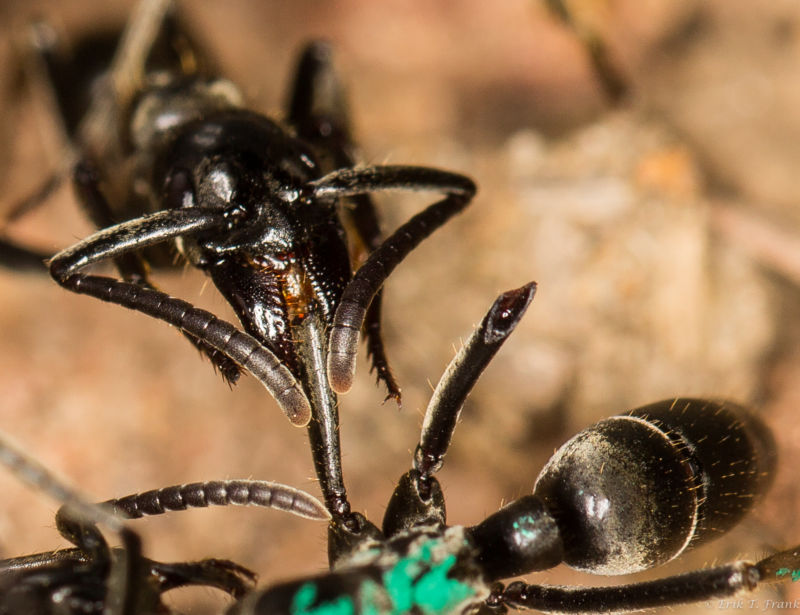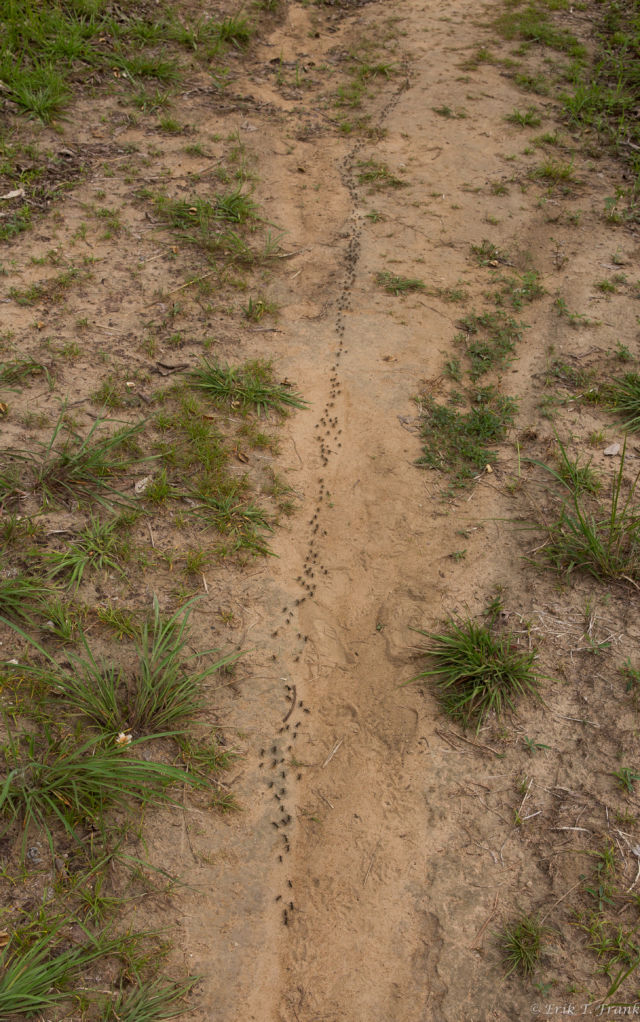In wars with termites, ants rescue and care for their wounded

Deadly battles play out several times a day in the Ivory Coast’s Comoé National Park, leaving wounded behind. The fights break out when hundreds of African Matabele ants march off to raid a nearby termite mound to slaughter termite workers and haul them back to the nest to feed the colony. But termites, with their strong, sharp mandibles, aren’t easy prey, and raiders often get limbs bitten off in the fight.
In the aftermath of a raid, researchers are finding evidence that the ants care for their wounded. The wounded ants secrete a pheromone that calls other returning raiders to carry their injured comrades home. Back at the nest, healthy nest-mates clean the injured ants’ wounds. And the behavior of injured ants even creates a triage system so that only the ants that might actually be saved get rescued.
“It’s only a flesh wound!”
Ants that are only missing a leg or two can generally make the 50-meter trek back to the nest, but their injuries make them more vulnerable to predators, so about a third of injured ants who try to walk home won’t make it. So when nest-mates are nearby, injured ants slow down and even develop a sudden tendency to fall over.
But “after the returning raid column had passed by without helping her, the injured ant immediately started to follow them at a faster pace,” ecologist Erik T. Frank and his colleagues wrote in their paper.
It may look like these ants are just hamming it up in a play for sympathy, but the behavior actually makes sense. Other ants’ eyesight may not be sharp enough to spot an injury, but they can recognize the slow, clumsy movements of an injured nest-mate. And a slower ant has more time to interact with passing nest-mates, which means better odds of getting picked up. Would-be helpers probably have an easier time pinpointing the source of a chemical distress beacon that’s not moving quickly.
When a rescuer touches a lightly injured ant with its antennae, the injured ant folds its remaining legs up in a position similar to a pupa and lies still, making itself easier to carry. But the most severely injured ants, those missing three or more legs, get left behind, in what looks like an uncanny mimicry of the triage human medics perform on battlefields and in disasters.
“It would be wrong to think that the ants are actually making conscious decisions,” Frank told Ars Technica.
Helpers don’t carry their injured nest-mates home out of compassion or loyalty—ants don’t have the cognitive ability to feel those things—instead they do it because chemical cues prompt them to pick up injured ants instead of dead termites. Similarly, said Frank, “The heavily injured ant does not tell the others to ‘leave her behind’ because she knows she won’t be of use anymore.”
Ants only secrete the “help” pheromone once they’ve managed to pull themselves into a standing position, and the injured ants’ reflex is to try to stand. If they succeed, their bodies secrete the pheromone. If not, they don’t. And even when Frank and his colleagues applied the pheromone to severely injured ants, their wild flailing made them too difficult to pick up and carry, so the would-be helpers eventually gave up and walked away.
“It’s actually what fascinates me most about social insects: the ability to have incredibly complex and sophisticated behaviours based on very simple rules and without cognition,” said Frank.
Best care anywhere
Back at the nest, rescued ants get the best medical care available—which means their nest-mates lick the open wounds where their legs used to be.
“The remaining part of the cut limb was held upwards and nest-mates carefully held the injured limb in place with their mandibles and front legs; this allowed them to intensely lick directly into the wound for up to four minutes at a time,” Frank and his colleagues wrote in their paper.

It’s likely that all that licking helps clean dirt out of the open wounds, and the helpful ants may even be applying an antimicrobial substance of some sort. Several ant species secrete such compounds in their saliva, and other ant species have been seen grooming nest-mates to help fight off fungal infections.
Frank plans to spend his post-doctoral research at the University of Lausanne figuring that out, testing various ant glands for antimicrobial or antifungal properties. He also wants to understand how the ants are able to pinpoint the injury—or tell each other where it hurts.
Changes in the injured ants’ cuticle or exoskeleton (a gaping hole, for instance) could indicate an injury to nest-mates, or they may look for hemolymph—the insect version of blood—draining from the wound. That could also be how ants know when to stop licking an injury; when the hemolymph stops flowing, it’s time to stop licking and move on. Frank still needs more data to test those ideas, though.
However treatment works, it’s clearly effective at preventing infection, and that clearly helps ants live to raid another day. Injured ants who didn’t receive care died 80 percent of the time, but when Frank and his colleagues put the injured ants on sterile soil, their mortality rate dropped to 20 percent. But ants that had nest-mates that licked their wounds only died 10 percent of the time.

For the greater good
Natural selection favors this triage, medevac, and wound care behavior not because it benefits individual ants—remember that the worker ants won’t breed in the first place—but because it improves the fitness of the colony. And that, according to Frank, may be why biologists have never observed this kind of behavior in any other animal species. “Treatment of a wound by another individual is much more beneficial in social insects where evolution generally applies on the level of the colony,” he said.
The benefit to the colony comes in the form of reducing the otherwise high cost of hunting tough prey like termites. Frank and his colleagues noticed that about 21 percent of ants on raiding parties were already missing at least one limb, and four- or five-legged ants learn to move almost as quickly as uninjured ants within about 24 hours. That means that rescuing and treating an injured ant puts it back in the fight the next day.
“By saving injured ants, the colony is able to reduce its mortality, i.e. its costs, when hunting dangerous prey like termites. Since these injured ants later on participate again in future fights, the colony does not need to produce new workers to replace them.”
Proceedings of the Royal Society B, 2017. DOI: 10.1098/rspb.2017.2457 (About DOIs).
https://arstechnica.com/?p=1259701